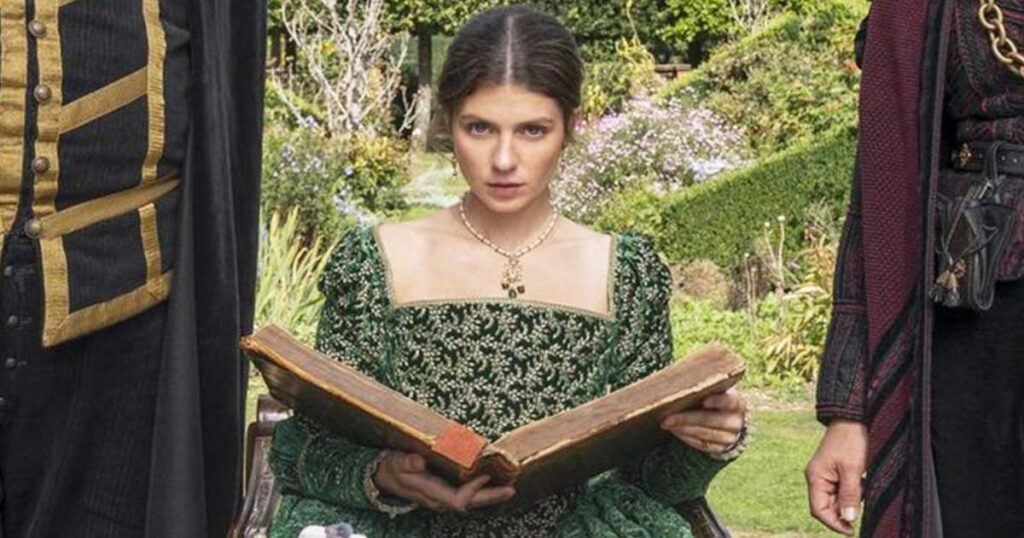
Prime Video’s My Lady Jane tells a fictionalized version of the story of English noblewoman, Lady Jane Grey, famously known as the ‘Nine Days’ Queen.’ Set in the 16th century, the show presents an alternate historical account of her life, incorporating the elements of comedy and fantasy. In reality, Lady Jane Grey met with a horrible end.
The Amazon series portrays what her life could have been if she had escaped death. Based on the book of the same name by Jodi Meadows, Brodi Ashton, and Cynthia Hand, the show incorporates fantastical elements like the shape-shifting Ethians, with a humorous and surreal take on history. Unfortunately, the real life of Lady Jane Grey was not as hunky-dory. Let’s take a look at the horrific true story of Lady Jane Grey.
Lady Jane Grey: The Nine Days’ Queen
Lady Jane Grey is a fascinating figure in English history, even though her time as queen was very short. She was the great-granddaughter of Henry VII and a cousin to Edward VI. Jane was born in 1537 to Henry Grey, 1st Duke of Suffolk, and Lady Frances Brandon.
Because of her family connections, she became an important political figure during a time of great religious and political changes in England. Jane received an exceptional education for a girl of her time. She was fluent in Latin, Greek, and Hebrew, and also learned French and Italian. Her teachers were some of the best scholars around, which shows how much was expected of her.
When Edward VI died in July 1553, there was a big question about who would be the next ruler. Edward, a Protestant, did not want his Catholic half-sister, Mary Tudor, to become queen. Influenced by his advisors, especially John Dudley, Duke of Northumberland, Edward named Lady Jane Grey as his successor. Jane’s Protestant faith made her a good choice for those who wanted to keep the Protestant religion in power.
On July 10, 1553, Jane was proclaimed queen. However, her reign lasted only nine days. Mary Tudor quickly gained support, and by July 19, the Privy Council had switched their loyalty to Mary. Jane was no longer the queen and had to leave the throne, which was ascended by Mary.
The Tragic Execution of Lady Jane Grey
After she was deposed, Jane was imprisoned in the Tower of London. At first, it seemed like her life might be spared because Mary wanted to secure her own position and possibly show mercy to her young cousin. However, a rebellion led by Thomas Wyatt the Younger in early 1554 changed everything. The rebellion aimed to remove Mary and place either Elizabeth or Jane on the throne.
When the rebellion failed, Jane’s fate was sealed. She was tried for high treason, found guilty, and sentenced to death. During her trial, Jane showed great dignity and intelligence, showing her good education. She accepted her sentence calmly, relying on her faith to give her strength in her final days. On February 12, 1554, Lady Jane Grey was executed.
According to reports from that time, she faced her execution with remarkable calm and bravery and gave a short speech, admitting that she had wrongly accepted the throne but insisting that she had no evil intentions. “The fact, indeed, against the Queen’s highness was unlawful, and the consenting thereunto by me: but touching the procurement and desire thereof by me or on my behalf, I do wash my hands thereof in innocency, before God, and the face of you, good Christian people, this day,” she said in her speech.
Jane was beheaded at the age of 16-17, a young life tragically cut short by the power struggles of her time. Her execution was meant to be a political statement by Mary to strengthen her rule, but it has been remembered as a sad example of the human cost of political conflict. In contrast, My Lady Jane’s fictional Jane was found innocent after the trial, and her life was spared.
Lady Jane Grey’s life and death have left a lasting impact on English history. She is often seen as a tragic heroine, a victim of the ambitions of others. Her story has been romanticized in books and art, symbolizing the loss of innocence to political schemes. Jane’s legacy is also tied to the religious conflicts of her time. Her short reign and execution highlighted the fierce struggle between Protestantism and Catholicism in England.
However, Instead of focusing on the religious arguments, the makers of My Lady Jane chose to introduce fantasy elements like Ethians in the show. As a metaphor for the Protestants vs Catholics debate, the series showcases the struggle between people who advocate for Ethian rights and those who do not.
Historians have debated how much control Lady Jane Grey had over the events that led to her downfall. While some see her as a passive victim, others believe she was more politically aware than usually depicted. Regardless, her tragic end shows how dangerous power can be and how brutal political maneuvering often is.
All episodes of My Lady Jane are streaming on Prime Video.
Must Read: One Fast Move: Everything To Know About KJ Apa’s Action Film
Follow Us: Facebook | Instagram | Twitter | Youtube | Google News

